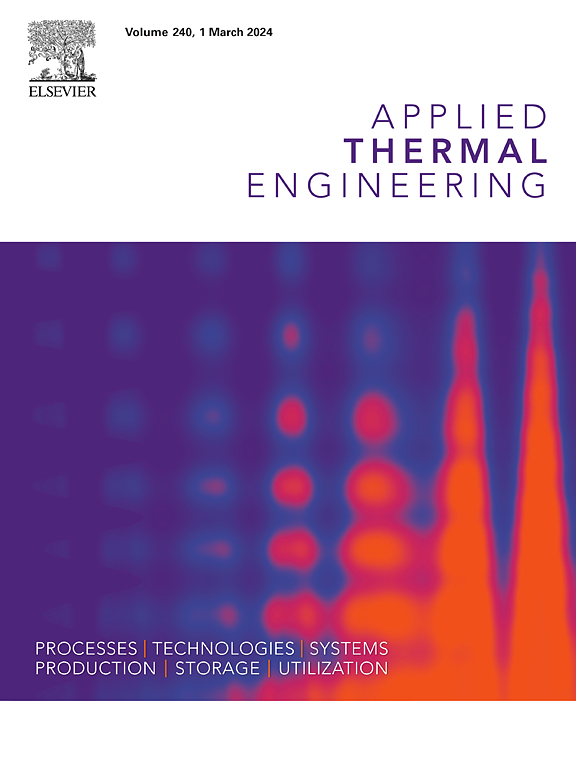Numerical study of Ultraviolet and Infrared radiation characteristics of pulsed detonation engine exhaust
IF 6.9
2区 工程技术
Q2 ENERGY & FUELS
引用次数: 0
Abstract
The radiation characteristics of pulsed detonation engine (PDE) exhaust have significant applications in engine performance monitoring, parameter inversion, and target detection. In this work, an effective model for predict the radiation characteristics of PDE exhaust is developed, both the Ultraviolet (UV) radiation from excited OH molecule (OH, ) and Infrared (IR) radiation from multiple species are considered. Specifically, the OH total number density is calculate by a combined chemical mechanism and the OH population is predicted based on an assumption of a local Boltzmann distribution within excited states. Furthermore, an enhanced Reverse Monte Carlo (RMC) method is proposed to address the radiation transfer. A three-dimensional transient PDE exhaust flow is simulated by Computational Fluid Dynamics (CFD), and the radiation characteristics of the exhaust are presented in detail. The results indicate that the developed model can calculate the exhaust radiation characteristics accurately. The PDE exhaust is similar to the supersonic free jet, with exhaust boundaries being more distinct in UV images, while IR images are more sensitive to shock structures. The and bands are identified as the two most distinctive spectral peaks, accompanied by several weaker peaks. Whether in the UV or IR band, the image radiance always decreases as the exhaust develops, while the spectral and integral intensities show different trends. The equivalence ratio has a significant impact, particularly on UV radiation. As the equivalence ratio increases, the UV radiation exhibits an enhancement by 1–3 orders of magnitude, while the variation in the IR radiation is relatively modest. The afterburning phenomenon influences UV radiation primarily by chemiluminescence reaction and IR radiation through heat release.
脉冲爆震发动机排气紫外和红外辐射特性的数值研究
脉冲爆震发动机排气辐射特性在发动机性能监测、参数反演和目标探测等方面具有重要的应用价值。本文建立了一种预测PDE废气辐射特性的有效模型,该模型考虑了OH分子(OH *, A2Σ+→X2Πr)的紫外辐射和多组分的红外辐射。具体地说,OH *总数密度是由一个组合的化学机制计算的,OH *居数是基于激发态内局部玻尔兹曼分布的假设来预测的。此外,提出了一种增强的反向蒙特卡罗(RMC)方法来解决辐射传输问题。利用计算流体动力学(CFD)对三维瞬态PDE排气流进行了模拟,详细分析了排气的辐射特性。结果表明,所建立的模型能较准确地计算排气辐射特性。PDE排气与超音速自由射流相似,紫外图像中排气边界更明显,而红外图像对激波结构更敏感。0.31μm和2.7μm波段是两个最明显的光谱峰,并伴有几个较弱的峰。无论在紫外波段还是红外波段,随着排气的发展,图像的辐射强度总是降低的,而光谱强度和积分强度则呈现不同的趋势。等效比有显著的影响,特别是对紫外线辐射。随着等效比的增加,紫外辐射增加了1-3个数量级,而红外辐射的变化相对较小。加力燃烧现象主要通过化学发光反应影响紫外辐射,通过放热影响红外辐射。
本文章由计算机程序翻译,如有差异,请以英文原文为准。
求助全文
约1分钟内获得全文
求助全文
来源期刊

Applied Thermal Engineering
工程技术-工程:机械
CiteScore
11.30
自引率
15.60%
发文量
1474
审稿时长
57 days
期刊介绍:
Applied Thermal Engineering disseminates novel research related to the design, development and demonstration of components, devices, equipment, technologies and systems involving thermal processes for the production, storage, utilization and conservation of energy, with a focus on engineering application.
The journal publishes high-quality and high-impact Original Research Articles, Review Articles, Short Communications and Letters to the Editor on cutting-edge innovations in research, and recent advances or issues of interest to the thermal engineering community.
 求助内容:
求助内容: 应助结果提醒方式:
应助结果提醒方式:


